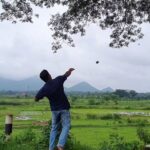Fourteen years ago, a 56-year-old villager from the remote region of Nubra in Ladakh gave all his four double-humped camels but one to a distant relative for the lack of resources to feed them. Now, Mohammad Ibrahim, 32-year-old, the son of the same villager keeps a troupe of eight camels to run a successful tourist safari business in the cold mountains of Nubra. While recalling the incident, Ibrahim says he has vivid idea, how father and he drove those camels for miles across white sand dunes to hand them over to an acquaintance in Diskit, a distant village.
Luckily, the one we kept back has become a source of prosperity for us now. I have raised almost a quarter dozen Bactrian camel and thank God, I use all of them for tourist safari, says Ibrahim who along with his two younger brothers is now running a successful camel safari business at his Hunder village in Nubra valley.
Once regarded as a burden and used exclusively as a means of local transport to carry loads and ration in the remote parts of Ladakh, the ship of mountain is now a main source of livelihood for scores of families in the region.

Not only Ibrahim, a sizeable progeny of youth from the historic tribal village is engaged now in running camel safaris and other tourist related services in the area, earning their livelihood.
Every day hundreds of tourists take their dream ride on sand dunes between Hunder and Diskit villages- a ride on Double Humped camel.
A famed ride:
A remote Hunder village in Ladakh’s Nubra valley has added many dimensions to mountain tourism. And a ride and that too on Double Humped Camel is never a miss among them. A large number of tourists in the village can be seen riding the camels and taking selfies with the prized animal.
“I had heard about this camel from a friend who has visited this place earlier. Since then, I dreamt of a ride and selfie with this fine friend,” says Raveena, a school teacher from Pune who is on a visit to Ladakh along with her husband. To ride this type of a unique camel is really a life time experience, a jubilant Raveena adds.

According to Feroz Ahmad, a local tour operator from Nubra Valley, hundreds of tourists visit the valley every day. From mountain biking, trekking, heritage trips to cultural exploration, these tourists engage in a variety of pursuits. However, the one must have pleasure for all these people seem the camel ride and taking selfies with the prized animals. The Bactrian camel has of late turned into a source of handsome seasonal income for the youth in the area.
Once a rare view in the village, a new symbol of popularity amidst nestled rocky mountains, the double hemp camels have grown in numbers too.
Growing Numbers:
Once struggling to survive in the Seventies, the population size of India’s only Double Humped camel found in Nubra witnesses an uptick. From about 40 camels a decade ago, there are hundreds of these camels now in the region.
According to Mohammad Iqbal, Chief Animal Husbandry Officer, Leh, there are 298 Double Humped camels in the region as per the latest census conducted by the department.
Experts believe that the main reason behind the growth in population of otherwise critically endangered species in the region is their usefulness in generating income for many local families through tourist safaris.

As per the camel keepers they earn about Rs 1500–2000 from a camel per day during the season. However the animal needs a special care.
Double the Hump, Double the Care
Most of the Bactrian camels feed on Seabuckthorn, a prominent shrub found commonly in community grazing fields in the region. However, the shrub is only available during few months of summer.
Ibrahim says, that it is very hard to feed the animal during winters, as the region lacks any viable plant material due to severe cold.
“Our women collect alfalfa hay from the wild to feed the animals during winter season. But as the numbers of animals have increased, one does not get sufficient hay for the animals. So every winter the fodder for the camel become unaffordable,” says Ibrahim. He adds that during winters they spend a good amount to feed them.

Hard work apart, the Double Humped camel has given a new identity to historically important Hunder village.
The Last Remnants of Silk Route
Found in good numbers now in Nubra Valley’s Hunder village about 135 kilometers from Leh city, the Double Humped Camel is believed to have come to Ladakh from neighbouring Tibetan region during the 17th century. Apart from Ladakh in India, the prized camel is found in Hor region of Central Asia.
According to P. Stobdan, who works as a teacher in Government-run higher secondary school at Chochut, Leh was a part of famed Silk Route. Till recently the region remained an important transit point on historic route. These camels were widely used to carry loads and goods for the trade. However, after the closure of Silk route in 1950, few camels were left back in the region, which are now widely used in tourism activities in the region.
The lead image at the top shows the tourist enjoying their ride on the back of Bactrian camels riding in a perfect line in Nubra (Photo by Nasir Yousufi)
Nasir Yousufi is a journalist based in Srinagar.








